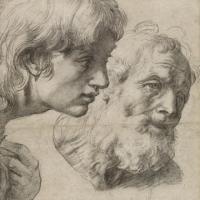RAPHAEL AND THE ELOQUENCE OF DRAWING
About the research project

Studies of two Apostles for the Transfiguration, Raphael, c. 1519-1520
Renaissance art is based on drawing, which in art history is generally viewed as a project-oriented activity: drawings are seen as links in a progression towards the final, polished work of art. Raphael has long been characterised as pragmatic and utilitarian in his drawing practice and modern audiences tend to perceive his art as bland, idealised or sentimental. This research project aims to transform both art-historical and public understanding of Raphael, using the concept of eloquence as a starting point.
Eloquence embraces the intimacy of making and of viewing, and has resonance across many academic disciplines. In drawing, the artist’s hand works in tune with memory, observation and imagination to gather and give shape to ideas. Eloquence can be traced in the affective power of drawings; in drawing as process and discovery and as communication and performance; and in drawings as active material works that respond to new ways of looking. These aspects chime with recent studies in social anthropology and in fine art that explore the embodied knowledge of the artist’s hand and the idea of gestural drawing as a mode of discovery.
Research aims
This project has been driven by the following research questions:
- Can we transform understanding of Raphael through a focus on the experimental character of drawing and its rhetorical possibilities?
- With the concept of rhetoric as an underlying structure, can we trace Raphael’s specific mode of visual invention and persuasive communication? How can this help us to arrive at a new understanding of his drawing as a gestural and visual language?
- Using a multidisciplinary approach, can we examine Raphael’s practice as a conceptual art and as an active mode of research and discovery? As a result can we identify a new approach to studying Renaissance drawing?
- How can an exploration of the relationship between drawing and oratory transform our ideas of how Raphael and his contemporaries conceptualised and experienced drawing?
- How might drawing be understood as eloquent in 16th-century Italy, and what are the implications for the social activity of admiring or collecting graphic art?
The project methodology involves the close scrutiny and analysis of drawings in national and international collections in order to understand their techniques and processes, and to identify their cognitive and expressive dimensions. The project has greatly benefitted from the technical investigations of the Ashmolean’s Paper Conservation Department. It has used interdisciplinary workshops to transcend disciplinary boundaries and open new perspectives on Raphael and Renaissance art.
Project team led by
Research Connections
British Museum, London
The Royal Collection, Windsor
Scottish National Gallery, Edinburgh
Musée du Louvre, Paris
Palais des Beaux Arts, Lille
Gallerie degli Uffizi, Florence
Städel Museum, Frankfurt
Teylers Museum, Haarlem
The Albertina, Vienna
Szépmüvészeti Múzeum, Budapest
Christ Church, Oxford
Outputs
Exhibition ‘Raphael: The Drawings’. 1st June–3rd September 2017. Ashmolean Museum, Oxford.
Interdisciplinary Workshop ‘Drawing and Raphael’. 26th June 2017. Ashmolean Museum, Oxford.
Session ‘New approaches to Raphael and Drawing’ at the Ashmolean Museum Research Seminar. 11th May 2017. Ashmolean Museum, Oxford.
Session ‘Drawing and Eloquence: New Approaches to Raphael’ at the Italian Studies at Oxford seminar. 9th February 2017. Oxford.
Interdisciplinary Workshop ‘Thinking with Drawing’. 9th January 2017. TORCH (The Oxford Research Centre in the Humanities) and Ashmolean Museum.
Interdisciplinary Workshop ‘The Intelligent Hand: The Persuasive Language of Drawing’. 28th June 2016. St John’s College Research Centre and the Ashmolean Museum, Oxford.
Publications
Aceto. A, (2018 forthcoming) ‘Raphael in three early drawings c.1499 (and a source for the Massacre of the Innocents)’, in 'Mitteilungen des Kunsthistorischen Institutes in Florenz'.
Whistler, C., Thomas, B. and Aceto, A. with an essay by Gnann, A. (2017). ‘Raphael: The Drawings‘. Oxford: Ashmolean Museum.
Thomas, B. and Whistler, C. (2016). 'Eloquence in Raphael Drawings'. Artibus et Historiae 74: 25-36.




